Leading electronics manufacturer Standard Horizon has proudly launched its new HX870E 6W handheld DSC VHF transceiver with built-in GPS, an upgrade of the hugely popular HX851E.
Whilst still having all of the intuitive features of its predecessor, a major new feature is the ability to plot up to 20 routes from a directory of 200 waypoints; greatly enhancing the radio’s functionality as a navigation aid.
The new model also has a much larger screen, whilst the battery capacity has increased from 1150mAh to a powerful 1800mAh.
Other new features include a Group Monitoring function, which allows the positions of up to 9 other HX870E users to be shown on the screen’s compass-style display, ideal for flotilla sailing or sea angling events, and achieved by the automatic position polling of selected, pre-programmed vessels.
A Man Overboard soft key icon has also been added which enables the user to immediately mark the position in the case of emergency.
The backlit dot matrix screen is 1.7in x 1.7in (43.2mm x 43.2mm) or 2.3in diagonal (58.42mm). The increased size has allowed for the addition of screen icons which, combined with the three soft keys, makes navigation of the radio’s function more intuitive and quicker than ever.
The new HX870E is built on a die cast chassis which enables it to cope with the harshest environment and the submersible waterproof rating is IPX8 (5 feet for 30 minutes).
Yet another new and important feature is that the automatic distress strobe will flash a bright SOS the moment the radio hits the water, even if the radio is switched off at the time.
The Class D DSC VHF has all the main marine transceiver channels, plus VHF channel 70 set aside on a separate receiver for DSC operation. The set also has a DSC test call facility and automatic DSC channel change selector. The front keys give access to programmable scan, priority scan, dual watch and tri-watch, with a preset key to recall any of 10 favourite channels. There is also a noise-cancelling function for both the transmission and receiver audio. The dedicated distress button is located on the side of the set (not visible in the photo) with the red-coloured Channel 16 key on the front.
With the E suffix denoting the set’s EU configuration, the mandatory ATIS (Automatic Transmitter Identification System) can be activated via the front panel for use on the inland waterways of Europe.
To allow the HX870E to connect with other on board devices, such as a laptop for uploading waypoint information, the casing features a USB data port that can output NMEA sentences (DSC, DSE, GLL, RMC, GSA, GSV and GGA) at a rate of 9600 baud.
The HX870E can run from several power sources, including via a 240V AC mains converter or 12V DC adapter, which can fully recharge the Li-ion battery in 3 hours, or from an interchangeable tray of 5 AAA alkaline batteries.
As with all of Standard Horizon’s waterproof products, the remarkable new HX870E is covered by a no-quibble three-year warranty, and features the kind of specification and versatility you would usually expect to find on a dashboard-mounted class D VHF transceiver.
Specification:
- Model: Standard Horizon HX870E
- Power output: 1/2/6/W @ 7.4V
- Frequency ranges: 156.025 MHz to 157.425 MHz
- Battery: 1800mAh Lithium-Ion.
- Size: 2.44” x 5.43” x 1.69” (62 x 138 x 43mm) w/o knob and antennae
- Weight: 11.36oz (322gm) w/SBR-13Li, belt clip and antenna)
- RRP: £229.95 including VAT
* UK Users should be aware that the use of this device requires an individual Ship Portable Radio Licence with a MMSI number commencing ‘2359’ separate from any Ship Radio Licence which may already be held. A Ship Portable Radio Licence with MMSI number can be obtained online from OFCOM at www.ofcom.org.uk Other European Users should check with their local PTT for licencing information.

